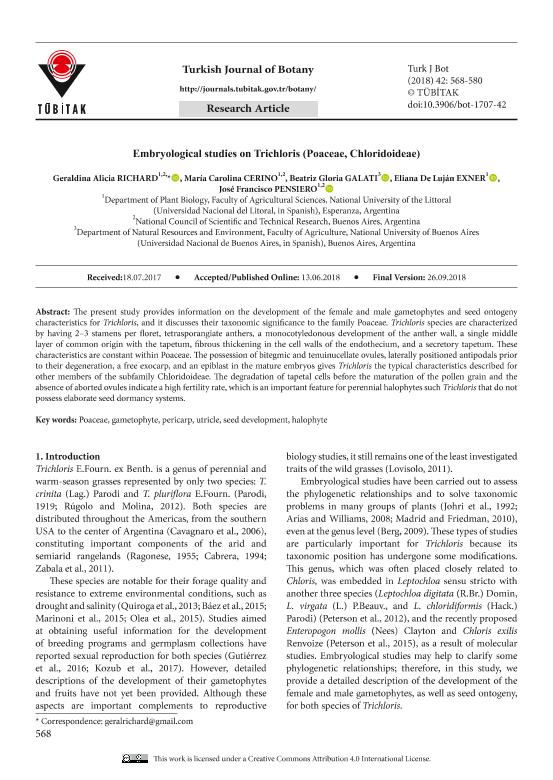Artículo
Embryological studies on Trichloris (Poaceae, Chloridoideae)
Richard, Geraldina Alicia ; Cerino, María Carolina
; Cerino, María Carolina ; Galati, Beatriz Gloria; Exner, Eliana de Luján
; Galati, Beatriz Gloria; Exner, Eliana de Luján ; Pensiero, Jose Francisco
; Pensiero, Jose Francisco
 ; Cerino, María Carolina
; Cerino, María Carolina ; Galati, Beatriz Gloria; Exner, Eliana de Luján
; Galati, Beatriz Gloria; Exner, Eliana de Luján ; Pensiero, Jose Francisco
; Pensiero, Jose Francisco
Fecha de publicación:
06/2018
Editorial:
Tubitak Scientific & Technical Research Council Turkey
Revista:
Turkish Journal of Botany
ISSN:
1300-008X
Idioma:
Inglés
Tipo de recurso:
Artículo publicado
Clasificación temática:
Resumen
The present study provides information on the development of the female and male gametophytes and seed ontogeny characteristics for Trichloris, and it discusses their taxonomic significance to the family Poaceae. Trichloris species are characterized by having 2–3 stamens per floret, tetrasporangiate anthers, a monocotyledonous development of the anther wall, a single middle layer of common origin with the tapetum, fibrous thickening in the cell walls of the endothecium, and a secretory tapetum. These characteristics are constant within Poaceae. The possession of bitegmic and tenuinucellate ovules, laterally positioned antipodals prior to their degeneration, a free exocarp, and an epiblast in the mature embryos gives Trichloris the typical characteristics described for other members of the subfamily Chloridoideae. The degradation of tapetal cells before the maturation of the pollen grain and the absence of aborted ovules indicate a high fertility rate, which is an important feature for perennial halophytes such Trichloris that do not possess elaborate seed dormancy systems.
Palabras clave:
GAMETOPHYTE
,
HALOPHYTE
,
PERICARP
,
POACEAE
,
SEED DEVELOPMENT
,
UTRICLE
Archivos asociados
Licencia
Identificadores
Colecciones
Articulos(CCT - SANTA FE)
Articulos de CTRO.CIENTIFICO TECNOL.CONICET - SANTA FE
Articulos de CTRO.CIENTIFICO TECNOL.CONICET - SANTA FE
Citación
Richard, Geraldina Alicia; Cerino, María Carolina; Galati, Beatriz Gloria; Exner, Eliana de Luján; Pensiero, Jose Francisco; Embryological studies on Trichloris (Poaceae, Chloridoideae); Tubitak Scientific & Technical Research Council Turkey; Turkish Journal of Botany; 42; 5; 6-2018; 568-580
Compartir
Altmétricas



